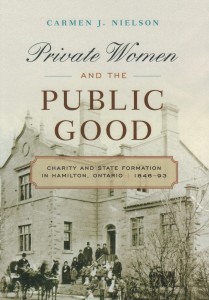So much Canadian literature is to history what McLobster is to shellfish, an ersatz experience in which facts are processed to the point of blandness. It fills but never satisfies, and makes you pity those who never tasted the real thing.
And then there is this gem by historian Carmen J. Nielson of Mount Royal University. Private Women documents social welfare on the frontier. The narrative turns on a specific time and place – Hamilton, Ont., circa 1850 – but it could be Anytown Canada in the age before government initiatives. This is history no TV producer could re-enact. The film set would be raided by the Children’s Aid Society.
Hamilton in 1846 was a brawling port of Protestant burghers and Catholic labourers that prided itself as the Manchester of Upper Canada. It was home to mills and factories, a steamboat landing and the Great Western Railway, three newspapers and periodic outbreaks of cholera.
The alleys were filthy and poverty was desperate. Professor Nielson notes the only public welfare institution was the local jail: “No formal state provisions had been made for coping with destitute individuals, so responsibility for poor relief most often fell to churches or private individuals and less often to magistrates and local governments.”
The result was appalling. Whole families scavenged for food. Children were apprenticed to mills at age 8. Mothers stole bread and firewood. In 1846 amid the squalor a group of 48 wives and mothers, all “white, middle-class Protestant women,” formed a Ladies’ Benevolent Society with a single purpose: “The investigation and relief of cases of distress and destitution from sickness, poverty or similar causes.”
Members paid a subscription fee of five shillings and were assigned to different wards of the city to mind the destitute. They distributed groceries and counselled orphans and runaways who wandered the streets of the city. The Ladies’ Benevolent Society was almost revolutionary, Nielson writes. For centuries charity was considered the public duty of the very rich. Benevolent societies of the Dickens era were modeled on the concept of the joint stock company.
“Western capitalists with relatively small amounts of money to invest recognized if they pooled their resources they could finance projects that required very large investments, such as building canals and bridges,” Nielson writes. So it was that charitable societies “allowed men and women of the new middle classes to subscribe relatively small sums of money to undertake significant benevolent endeavours.”
From 1848 the ladies of Hamilton operated a day school and orphanage and later an old folks’ home. Private Women is richly researched and recounts those who passed through the doors: Willie, a drunkard’s son, “totally neglected”; Harriet, a girl whose mother’s character “is not good” and was known to police – a prostitute, perhaps; and Jimmy, an incorrigible delinquent taken in by the Orphan’s Home but expelled within days for trying to “corrupt the other boys.”
Jimmy’s sins are lost to history. Was it smoking? Drinking? Playing Three-Card Monte? The boy was driven out and last seen “wandering the streets” of Hamilton.
The regimen at the orphanage was plain and purposeful: Rise at 6, prayers and breakfast, an hour of play, lessons till 5 pm, bedtime at 7. Beatings were uncommon. Children were taught useful skills in the kitchen and workshop.
In time such private charities were overtaken by government aid. Ontario passed an Industrial Schools Act in 1874 and a Children’s Aid Act in 1893. The Hamilton orphanage closed in 1914 and today is forgotten but for Private Women, a compelling account of hardship and charity too raw for textbook processing.
By Holly Doan
Private Women And The Public Good, by Carmen J. Nielson; University of British Columbia Press; 176 pages; ISBN 9780-7748-16921; $24.95






